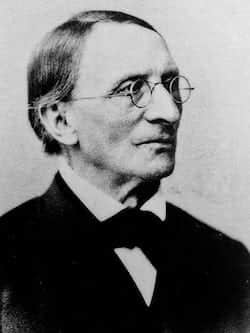Carl Ludwig

Carl Friedrich Wilhelm Ludwig (1816 – 1895) was a German physician and physiologist.
Designed the world’s most advanced experimental laboratory, which has spawned eponyms – both directly and indirectly
Described as having intellectual generosity and legendary unselfishness in order to further the careers of his pupils
Invented the kymograph in 1847, allowing graphical recording of physiological events. It could record simultaneously variables such as blood pressure, pulse rate and respiratory rate. It is an instrument which has a stylus connected to a mercury manometer with a rotating smoke drum, allowing such recordings
Biography
- Born 29 December 1816 – Witzenhausen, Germany
- Studied at universities in Marburg, Erlangen and Bamburg
- 1839 – appointed assistant in anatomy at the University of Marburg, where he also worked in Robert Bunsen’s chemical laboratory
- 1847 – first discovered sinus arrhythmia
- 1849 – Chair of Anatomy and Physiology, University of Zurich
- 1852 – published the first volume of his classic textbook of physiology, Lehrbuch der Physiologie des Menschen
- 1855 – Professor of Anatomy and Physiology at the Josephinium in Vienna
- 1865 – Professor of Physiology at the University of Leipzig
- 1869 – designed a new physiology institute at Leipzig with the financial support of King Johann of Saxony. It was the most advanced experimental laboratory in the world. He led this laboratory for almost three decades
- 1884 – Copley Medal for “…his investigations in physiology, and the great services which he has rendered to physiological science“
- Died 23 April 1895
Key Medical Attributions
Vast in number, many in conjunction with students working in his laboratory
- In his dissertation he developed the filtration theory of urine formation
- Invention of the kymograph, leading to discovery of sinus arrhythmia
- First to measure pulmonary artery pressure and capillary pressure
- Measured regional blood flow for the first time
- Discovered the ‘accelerator nerve of the heart’
- Discovered the ‘all-or-none’ law of cardiac muscle and the ‘treppe’ – or staircase – phenomenon
- Demonstrated the importance of vascular tone to maintain blood pressure
- Discovered vasomotor reflexes in 1866, and laid foundation for the discovery of circulatory autoregulation
- Located a ‘vasomotor centre’ in the medulla
- Invented a mercury blood pump allowing separation of respiratory gases in blood in vivo
- Demonstrated physiology of tissue oxygenation and gas exchange
- Created a model consisting of an isolated frog heart perfuse with defibrinated blood which could be kept beating for several days. This led to many important discoveries, including Luciani periods; paving the way for discovery of second degree AV block
- Anatomical studies of the myocardium, the kidney, eye and inner ear vasculature
Medical Eponyms
- None of his own, though many famous names have passed through his laboratory
- Carl-Ludwig-Institute of Physiology
Controversies
His laboratory set up, and financial support were envied worldwide. In 1879 Horatio C Wood, pharmacologist, surgeon and educational reformer said
Ludwig is certainly a most skilled physiologist – I have never seen anything like his apparatus. But no one has impressed me as being far superior to our best American men in natural gifts.” He concluded that the productivity of the Leipzig laboratory was “chiefly the result of the system.
Said of Ludwig by Scottish pharmacologist Sir Thomas Lauder Brunton (1844-1916) in 1894:
More than to anyone else since the time of Harvey, do we owe our present knowledge of the circulation to Carl Ludwig.
Major Publications
- Ludwig C. Beiträge zur Kenntniss des Einflusses der Respirationsbewegungen auf den Blutlauf im Aortensysteme. Archiv für Anatomie, Physiologie und wissenschaftliche Medicin. 1847;242-302
- Ludwig C. Lehrbuch der Physiologie des Menschen. Heidelberg: C.F. Winter 1852
References
Biography
- Fye WB. Carl Ludwig. Clin Cardiol. 1991 Apr;14(4):361-3.
- Lüderitz B. Carl Friedrich Wilhelm Ludwig (1816-1895). J Interv Card Electrophysiol. 2004 Dec;11(3):221-2.
Eponymous terms
- Fye WB. Carl Ludwig and the Leipzig Physiological Institute: ‘a factory of new knowledge’. Circulation. 1986 Nov;74(5):920-8
- Ludwig CF. 1842–a landmark in nephrology: Carl Ludwig’s revolutionary concept of renal function. Kidney Int Suppl. 1994 Oct;46:1-23.
- Zimmer HG. Carl Ludwig: the man, his time, his influence. Pflugers Arch. 1996;432(3 Suppl):R9-22
- Schubert E. The theory of and experimentation into respiratory gas exchange–Carl Ludwig and his school. Pflugers Arch. 1996;432(3 Suppl):R111-9.
- Davis JM, Thurau K, Häberle D. Carl Ludwig: the discoverer of glomerular filtration. Nephrol Dial Transplant. 1996 Apr;11(4):717-20.
- Thurau K, Davis JM, Häberle DA. Carl Friedrich Wilhelm Ludwig: the founder of modern renal physiology. Pflugers Arch. 1996;432(3 Suppl):R68-72.
- Zimmer HG. The contributions of Carl Ludwig to cardiology. Can J Cardiol. 1999 Mar;15(3):323-9.
Eponym
the person behind the name
Dr Ben Mackenzie emergency medicine trainee | LinkedIn |
